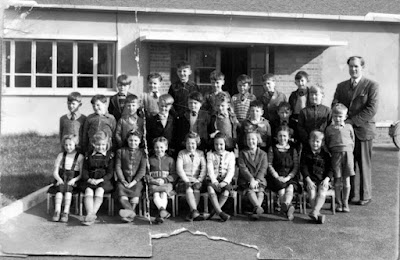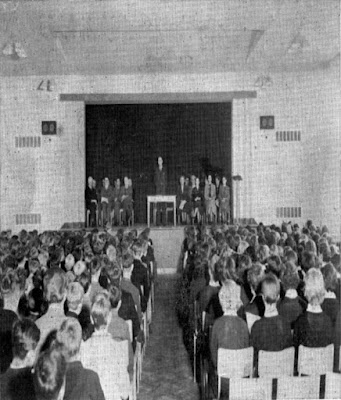We have already seen, in part one of this blog, how the 1944 Education Act drastically transformed schools in England and Wales. However, but not all councils embraced it. Welsh councils in rural areas tended to oppose change more than their counterparts in more urban areas, in part due to logistics: local geography and population density made change difficult.
Gareth Jones (2002) notes that some councils tried their best to resist the Ministry of Education’s Welsh Department tripartite system of secondary education attempts after 1944 [1] although there was general support for the end of elementary education [2]. In rural areas, the tripartite system was impractical and 'the Welsh Department of the Board of Education had little choice but to bow to this logic to an extent while preserving a bipartite system as far as possible.' [3] Jones gives the example of rural Radnorshire with fewer than three hundred children entering secondary education. Before the war, there were only two mixed secondary schools for the county, in addition to all-age elementary schools. Under the revision proposed by the Butler Act, all senior pupils would go to secondary / grammar schools across the county and the first two to three years provided a more general education. Jones writes that the Radnorshire LEA’s development plan was eventually approved - 'it resulted in only one bilateral school, one grammar school and two secondary modern schools with a further small school having the option of being either a grammar or modern school.' He goes on:
'Most rural county councils remained dominated by Independent or Liberal groupings and were more conservative in outlook than their industrial counterparts…The rural authorities were forced to propose some form of bilateral structure, sometimes with a common curriculum for the first two years of secondary schooling. The Welsh Department … was forced to accept a wholly bipartite system was impossible but there should be as many grammar schools as possible. The two-year common curriculum was ruled out.' [4]
Aberystwyth saw many changes brought about by Rab Butler’s post-war educational reforms. After the Act, several schools were established in Aberystwyth in the following decade, described in 1949 [5] as ‘The New Welsh Schools Experiment at Aberystwyth’ where Welsh medium schools were provided increasingly in North and South Wales.
(Readers may be interested in Tom Buswell’s fascinating posts about Aberystwyth schools during WWII [6, 7], their participation in the war effort and providing education for Liverpool evacuees.)
 |
| Penparcau Primary School 1945 https://www.peoplescollection.wales/items/44908 |
One local school in particular moved locations several times as demand grew. Ysgol Gymraeg, or Ysgol Gymraeg yr Urdd as it was originally known, was the first Welsh-medium school, opened in 1939 as a private school by Sir Ifan ab Owen Edwards with Norah Isaac as the head (and only) teacher and termly fees of four guineas. According to the National Archives currency converter, this represented two days wages for a skilled tradesman. By the end of WWII, the school had over seventy pupils and four teachers and had outgrown the available space.
 |
| Llwyn yr Eos School 1953. https://www.peoplescollection.wales/items/44917 |
The school moved to Plas Lluest, a former gentleman’s residence in Llanbadarn Fawr, as Ysgol Lluest but Isaac remained the head teacher until 1949. Throughout, the main principle was to preserve Welsh medium teaching with parents fighting ‘the local education authority to take over the school and … responsibility for Welsh language teaching.’ [8] Ysgol Gymraeg moved to Alexander Road in 1952 after being taken over by the LEA, moving next to Plascrug Leisure Centre, in 1989. The school’s website now notes over 400 enrolled pupils and eighteen teachers.
Llwyn yr Eos County Primary School in Penparcau opened on 5th December 1952. The building was extended from 1973-75 as Penglais Comprehensive. Secondary moderns persisted in England, Wales and Northern Ireland until the 1976 Education Act ended the tripartite system forever. Butler’s act brought in free secondary education and extended the school leaving age, but also subjected thousands of children to the tyranny of the eleven-plus. In Aberystwyth, the New Welsh Schools experiment also coincided with the expansion of Welsh medium teaching, something given a special prominence in the original proposals.
 | ||||
| Assembly - opening of Dinas Secondary Modern School, 8th November, 1955. https://www.peoplescollection.wales/items/44930 |
Following the Act, infants (4-7) were taught at Alexander Road School from September 1948 and children aged 7-11 went to North Road, with the rest of Alexandra Road reclassified as a Secondary Modern for 11+ pupils. [9]. North Road School became an English primary in 1951, catering for children between 5 and 11, with Welsh speaking pupils going to Alexander Road from September 1952. In September 1955, the senior section of Alexandra Road moved to the new Dinas Secondary Modern, at Cefn-llan, Waunfawr. [9]
 |
| Dinas Secondary Modern: https://www.peoplescollection.wales/items/44928 |
Blog by R. S. Pyne
SOURCES:
[1] Jones, G. E. (2002) Policy and Power: One hundred years of Local Education Authorities in Wales, Oxford Review of Education, 28, 343-58: https://doi.org/10.1080/0305498022014345
[2] Jones (2002) p. 350.
[3] Jones (2002) p 351
[4] Jones (2002) p 351-352
[5] Anon (1949) THE NEW WELSH SCHOOLS: EXPERIMENT AT ABERYSTWYTH. Times Educational Supplement (1,765), 138–.
[6] Tom Buswell (2021) ‘Aberystwyth Schools during WWII – part 1’– September 27th 2021.
People's Voices in a People's War: Aberystwyth 1939-1945: September 2021 (aberystwythatwarww2.blogspot.com)
[7] Tom Buswell (2021) ‘Aberystwyth Schools during WWII – part two’ October 5th 2021
People's Voices in a People's War: Aberystwyth 1939-1945: Aberystwyth schools during WWII - part two (aberystwythatwarww2.blogspot.com)
[8] (2009) ‘First Welsh-medium primary school celebrates 70th anniversary’ Wales Online https://www.walesonline.co.uk/news/wales-news/first-welsh-medium-primary-school-celebrates-2084865 (accessed 15th June 2022)
[9] Ceredigion Archives Website https://archifdy-ceredigion.org.uk/sched/sch.aby.html
Alexandra Road Board and North Road School – reference ABY/C and ABY/N respectively.




No comments:
Post a Comment